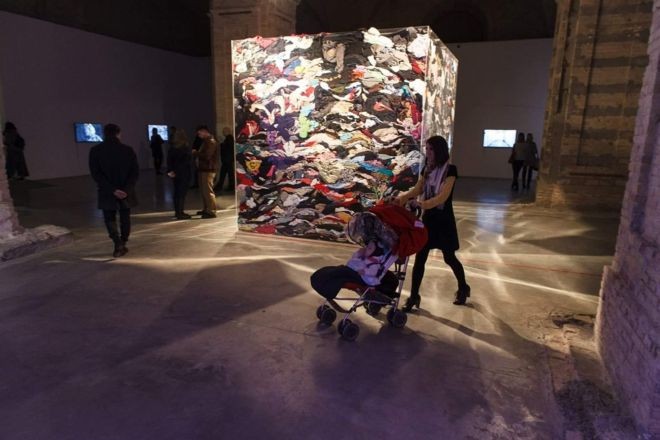
MYSTETSKYI ARSENAL. A cube sized of a three by three meters with a ton of old clothes. Installation that meets the visitors of the exhibition
A stork dropping red tulips on the tanks that shoot each other. You can see a sunflower with black petals and a black house near it, a soldier directs the gun at a girl.
These are the pictures of the displaced children. The pictures make up a great paper, The Palace of Non-children's Fairy Tales in the Mystetsky Arsenal. The drawings are a part of the exhibition What Is Your Name?, dedicated to the topic of migrants.
A tale of moving
What Is Your Name? is the first question that a child receives when it comes into a new group, kindergarten or school. 230 000 children have now been asked What Is Your Name? while they began adapting to a new life with this.
According to official data, there are 1.7 million migrants in Ukraine, 230 000 of them are children.
The exhibition is dedicated to the social integration of internally displaced persons and their families. According to Katia Taylor, the curator of the exhibition, its purpose is to show similarities but not differences. To demonstrate that all the people are united by common values and common habits. That we all want the same things: safety, comfort, and stability.
A large paper palace of artist Dasha Koltsova with quite non-children's fairy tales shows what kids who have seen war and left their own homes experienced. The kids drew pictures and told stories, quotes from which we can see on the walls: "If I need to tell a story about myself, then it would be called Moving to Another Place. "I feel sad, I don't want to paint, a shell destroyed our house and killed my dog, and then we had left it quickly.”
The installation called The Hall of Expectations plunges into the atmosphere and gives a feeling that will stay in the memories of these children. We can see a video with the kids from a modular village for the displaced near the city of Dnipro. They are running around and laughing, playing on the playground, which is not on the grass, or sand, but on the gravel. The same gravel is under the feet of the visitors of the exhibition.
These photos demonstrate, that there were the reasons to escape from.
"They spend their childhood like that. 91 modular houses were built for migrants in Ukraine, 3 thousands of people live there. 30 people in a building,” - Lera Lazarenko, co-curator of the exhibition says. "It's not possible to live there permanently. These people are kind of in limbo, they are somewhere between before and after."
The stories of the people from a modular unit are shown on the screens. They don't tell their names, just telling what they had gone through. A 90-year-old lady recalls how in 1941 she had been running away from the Germans and at the end of her life she had to escape once again from the bombardment of Horlivka.
"Why did you do such a terrible exhibition?"
"The visitors asked us why did we make such a terrible exhibition? Why do you show us all of these things?”- Lazarenko says showing the virtual reality project We Felt Cosy at Home.
A number of very strong and creepy photos are hanging on the walls. We can see here an attacked house, a seesaw against the background of the ruins, the interior of someone's ruined apartment. Wearing virtual reality glasses you can find yourself kind of in the middle of these photos, on the site where the pics were taken.
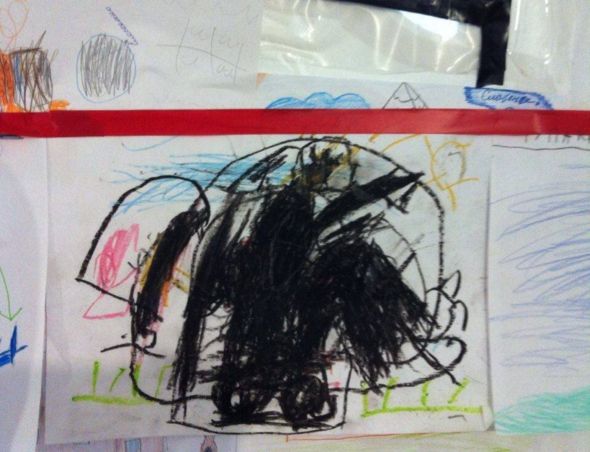 A children's drawing of the Palace of Non-Children's Fairy Tales
A children's drawing of the Palace of Non-Children's Fairy Tales
"We show it all because you cannot talk about the problem without showing it. It is here where you can feel the whole situation, feel the danger which the people fled from. These photos demonstrate, that there were the reasons to escape from,” - co-curator of the exhibition says.
Artist Serhiy Morhunov invites you to talk on an equal footing with children from the Donetsk region, to understand them. These are the kids who also moved, but still live near the line of fire, they hear the sounds of shells that might fly in their homes.
The children talk about their dreams in six videos. Someone wants to be a chef, because people like to eat, and someone dreams to become a trucker.
"The most effective communication is the one that takes place on an equal footing. The artist invites visitors to sit down on a chair and looking into the eyes of these children, to hear, to understand their problems and hopes. They have very simple dreams and wishes, they want to draw, to dance, to play football. They just want to be happy,” Ms. Lazarenko says.
Peonies in Saur-Mohyla
Saur-Mohyla is a very nice place where wild peonies grow, and you can see the sea of Azov from there in a clear weather. A 39-year-old Svetlana described her hometown Snizhne that way. She and other displaced people drew the map of the places they left during the psychotherapeutic interview. She painted them as she remembered. We can see the mines, chestnut alley, the house of her grandmother with her cherry jam without stones.
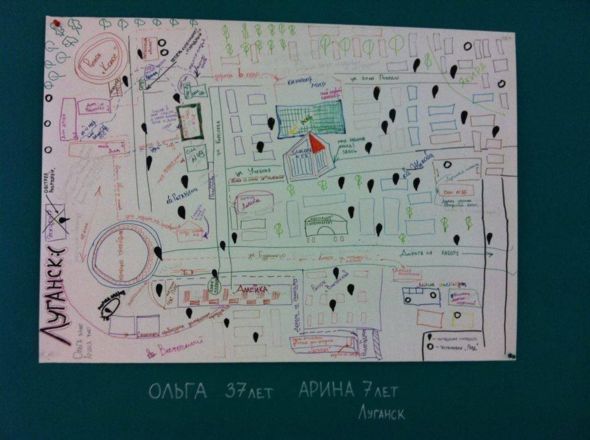 A map of Luhansk from places in which shells hit.
A map of Luhansk from places in which shells hit.
Such maps made by children and adults are the art project Odysseus of Donbas, which aims to shift the conversation about this region from the generalized to a personal level and to tell the story of its small towns.
Olha with her daughter Arina drew Luhansk with lots of black marks in places where the projectiles had fallen.
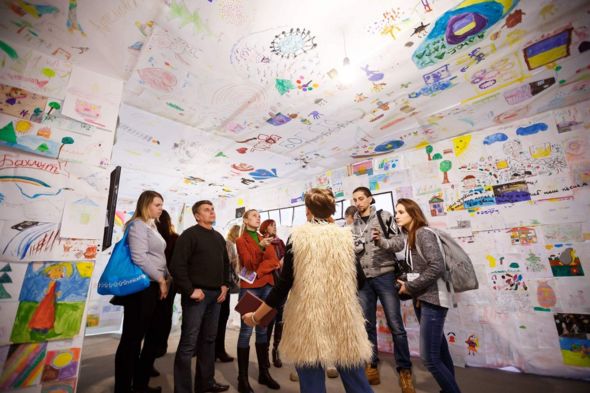 MYSTETSKY ARSENAL Palace of Non-Children's Fairy Tales from the inside out
MYSTETSKY ARSENAL Palace of Non-Children's Fairy Tales from the inside out
"It is a very great temptation to isolate migrants, they are often spared. But the attitude like that is uncomfortable for them as well, they feel they are a problem. We insist on the fact that from the perspective of positive psychology, the internally displaced persons are just people who have a special experience,” Lera Lazarenko says.
According to her, people reassess their experiences and find strength in it. Rita Voloshkova who moved from Donetsk, says that she is grateful for the fact that it happened to her. Yes, it left a scar on her, but now a 21-year-old girl considers herself fully independent. Rita's story posted next to the photo of those few things that she managed to take with her when she had left home.
The summary of the exhibition is the Hall of creation. It is important not to close, to deal with creativity, because art can help to heal and unite people, the organizers of the exhibition believe. Here you can see and take part in workshops, dialogues, screenings, stage productions.
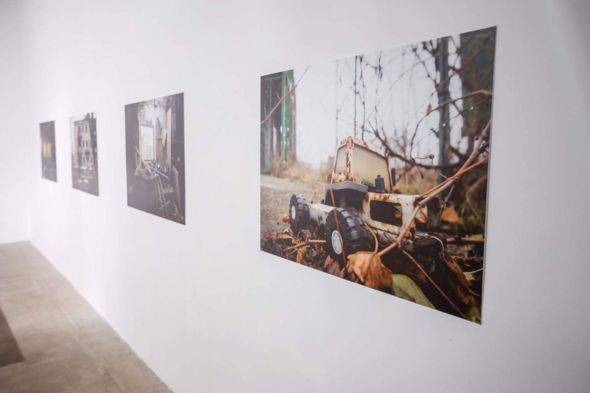 MYSTETSKY ARSENAL (ART ARSENAL) You can get into these pics. Virtual reality project created by the Film.ua Group
MYSTETSKY ARSENAL (ART ARSENAL) You can get into these pics. Virtual reality project created by the Film.ua Group
How to finish the war
You can read very touching stories about how people encountered various difficulties, hurt and pain in the Tiny Stories that were created under the auspices of UNICEF.
"It's very good that all the exhibition is not about the war, but there are such good things,” a visitor says reading a Tiny Story. There are not many visitors at the Arsenal in the morning hours. According to the organisers, there were many more visitors on the weekend. The exhibition will last until December 25.
"But there are still people here. They come, look around, ask questions. Because things like that make you think about it, think about things you didn't before. We hope that this project at least will help to change a bit the public attitude to the settlers,” Ms. Lazarenko says.
According to her, despite the traumatic experiences, children still believe in light and good things. In the Palace of Non-Children's Fairy Tales, next to a dark and terrifying pictures, we can see of a lot of light and good ones illustrating the superheroes who conquer evil.
"The war started because of the people abuse. And to end the war, people have to make peace among themselves,” - a story of a little girl is heard from the screen in the paper palace.